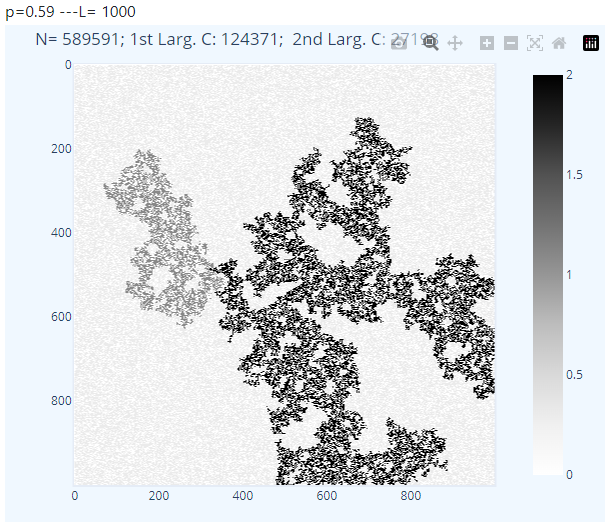%matplotlib inline
%config InlineBackend.close_figures=False;import matplotlib.pyplot as plt2;
import matplotlib.pyplot as plt;import numpy as np;from matplotlib import rcParams;import ipywidgets as widgets;from ipywidgets import Layout;from IPython.display import display,clear_output;import pylab as lp;from pylab import *;from scipy.ndimage import measurements;from IPython.display import display,clear_output;import numpy as np;import warnings;warnings.filterwarnings('ignore');N=100;cc=-0.01;R = np.random.random((N,N));colors = ['red','black','white'];cmap = mpl.colors.ListedColormap(colors);plt.ioff();out=widgets.Output();button=widgets.Button(description='Next');vbox=widgets.VBox(children=(out,button));display(vbox);f = plt.figure(figsize=(15,5));ax1 = f.add_subplot(121);ax2 = f.add_subplot(122);ax2=plt.gca();plt.ylim(0,1);plt.xlim(0,1);plt.grid();cc=0;
ax2=plt2.gca();
def click(b):
global cc; cc +=0.02; B = np.where(R < cc, 1, 0); B1=logical_not(B)*1; lw, num = measurements.label(B); w=np.max(lw); area = measurements.sum(B, lw, index=arange(lw.max() + 1)); sB=B.sum(); w1=np.max(area); ix=[i for i, x in enumerate(area) if x == w1]; a = np.array(ix); C = np.where(lw ==a[0], 1, 0); C1 = logical_not(C)*1; D=B1+C1; ama = logical_not(D)*1; sama=ama.sum(); p=sB/(N*N); im = ax1.imshow(D, cmap=cmap, interpolation='nearest');
with out:
ax2.plot(p,sama/sB,'ro-'); display(ax1.figure); print("p= ",p, "c= ",sB,"LC= ",sama," Author: S.Boutiche"); clear_output(wait=True);
ax2.set_xticks(np.arange(-0.0, 1, 0.1));ax2.set_yticks(np.arange(-0.0, 1, 0.1));ax2.set_xlim([0,1.0]);ax2.set_ylim([0,1.0]);ax2.grid();plt2.title('Percolation function');plt2.grid();ax2.set_xlabel('percolation probability (percolation threshold at pc=0.5927)');ax2.set_ylabel(r'$\theta$(p)');
button.on_click(click);
click(None);
